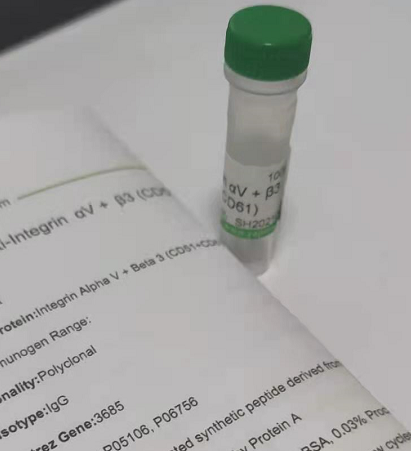| 產(chǎn)品編號(hào) | Ys-2756R |
| 英文名稱 | CYLD |
| 中文名稱 | 微管結(jié)合蛋白CYLD抗體 |
| 別 名 | CDMT; cylindromatosis (turban tumor syndrome); cylindromatosis 1; Deubiquitinating enzyme CYLD; EAC; HSPC057; KIAA0849; turban tumor syndrome; Ubiquitin thiolesterase CYLD; Ubiquitin-specific processing protease CYLD; CYLD_HUMAN; Ubiquitin carboxyl-terminal hydrolase CYLD; CYLD; BRSS; CDMT; CYLD1; CYLDI; EAC; MFT; MFT1; SBS; TEM; USPL2. |
| 抗體來(lái)源 | Rabbit |
| 克隆類型 | Polyclonal |
| 交叉反應(yīng) | Human, Mouse, Rat, (predicted: Chicken, Cow, Horse, ) |
| 產(chǎn)品應(yīng)用 | WB=1:500-2000 ELISA=1:5000-10000 IHC-P=1:100-500 IHC-F=1:100-500 Flow-Cyt=2ug/Test IF=1:100-500 (石蠟切片需做抗原修復(fù)) not yet tested in other applications. optimal dilutions/concentrations should be determined by the end user. |
| 理論分子量 | 105kDa |
| 細(xì)胞定位 | 細(xì)胞漿 細(xì)胞膜 |
| 性 狀 | Liquid |
| 濃 度 | 1mg/ml |
| 免 疫 原 | KLH conjugated synthetic peptide derived from human cylindromatosis 1: 501-600/956 |
| 亞 型 | IgG |
| 純化方法 | affinity purified by Protein A |
| 緩 沖 液 | 0.01M TBS(pH7.4) with 1% BSA, 0.03% Proclin300 and 50% Glycerol. |
| 保存條件 | Shipped at 4℃. Store at -20 °C for one year. Avoid repeated freeze/thaw cycles. |
| 注意事項(xiàng) | This product as supplied is intended for research use only, not for use in human, therapeutic or diagnostic applications. |
| PubMed | PubMed |
| 產(chǎn)品介紹 | Defects in CYLD are the cause of familial cylindromatosis (CYLD) also known as turban tumor syndrome or dermal eccrine cylindromatosis. CYLD is an autosomal dominant and highly tumor type-specific disorder. The tumors (known as cylindromas because of their characteristic microscopic architecture) are believed to arise from or recapitulate the appearance of the eccrine or apocrine cells of the skin that secrete sweat and scent respectively. Cylindromas arise predominantly in hairy parts of the body with approximately 90% on the head and neck. The development of a confluent mass which may ulcerate or become infected has led to the designation "turban tumor syndrome". The skin tumors show differentiation in the direction of hair structures, hence the synonym trichoepithelioma. CYLD has deubiquitinating activity. Function: Protease that specifically cleaves 'Lys-63'-linked polyubiquitin chains. Has endodeubiquitinase activity. Plays an important role in the regulation of pathways leading to NF-kappa-B activation. Contributes to the regulation of cell survival, proliferation and differentiation via its effects on NF-kappa-B activation. Negative regulator of Wnt signaling. Inhibits HDAC6 and thereby promotes acetylation of alpha-tubulin and stabilization of microtubules. Plays a role in the regulation of microtubule dynamics, and thereby contributes to the regulation of cell proliferation, cell polarization, cell migration, and angiogenesis. Required for normal cell cycle progress and normal cytokinesis. Inhibits nuclear translocation of NF-kappa-B. Plays a role in the regulation of inflammation and the innate immune response, via its effects on NF-kappa-B activation. Dispensable for the maturation of intrathymic natural killer cells, but required for the continued survival of immature natural killer cells. Negatively regulates TNFRSF11A signaling and osteoclastogenesis Subunit: Interacts (via CAP-Gly domain) with IKBKG/NEMO (via proline-rich C-terminal region). Interacts with TRAF2 and TRIP. Interacts with PLK1, DVL1, DVL3, MAVS, TBK1, IKKE and DDX58. Interacts (via CAP-Gly domain) with microtubules. Interacts with HDAC6 and BCL3. Interacts with SQSTM1 and MAP3K7. Identified in a complex with TRAF6 and SQSTM1. Subcellular Location: Cytoplasm. Cytoplasm, perinuclear region. Cytoplasm, cytoskeleton. Cell membrane; Peripheral membrane protein; Cytoplasmic side. Note=Detected at the microtubule cytoskeleton during interphase. Detected at the midbody during telophase. Tissue Specificity: Detected in fetal brain, testis, and skeletal muscle, and at a lower level in adult brain, leukocytes, liver, heart, kidney, spleen, ovary and lung. Isoform 2 is found in all tissues except kidney. Post-translational modifications: Phosphorylated on several serine residues by IKKA and/or IKKB in response to immune stimuli. Phosphorylation requires IKBKG. Phosphorylation abolishes TRAF2 deubiquitination, interferes with the activation of Jun kinases, and strongly reduces CD40-dependent gene activation by NF-kappa-B. DISEASE: Familial cylindromatosis (FCYL) [MIM:132700]: Autosomal dominant and highly tumor type-specific disorder. The tumors (known as cylindromas because of their characteristic microscopic architecture) are believed to arise from or recapitulate the appearance of the eccrine or apocrine cells of the skin that secrete sweat and scent respectively. Cylindromas arise predominantly in hairy parts of the body with approximately 90% on the head and neck. The development of a confluent mass which may ulcerate or become infected has led to the designation 'turban tumor syndrome'. The skin tumors show differentiation in the direction of hair structures, hence the synonym trichoepithelioma. Note=The disease is caused by mutations affecting the gene represented in this entry. Multiple familial trichoepithelioma 1 (MFT1) [MIM:601606]: Autosomal dominant dermatosis characterized by the presence of many skin tumors predominantly on the face. Since histologic examination shows dermal aggregates of basaloid cells with connection to or differentiation toward hair follicles, this disorder has been thought to represent a benign hamartoma of the pilosebaceous apparatus. Trichoepitheliomas can degenerate into basal cell carcinoma. Note=The disease is caused by mutations affecting the gene represented in this entry. Brooke-Spiegler syndrome (BRSS) [MIM:605041]: An autosomal dominant disorder characterized by the appearance of multiple skin appendage tumors such as cylindroma, trichoepithelioma, and spiradenoma. These tumors are typically located in the head and neck region, appear in early adulthood, and gradually increase in size and number throughout life. Note=The disease is caused by mutations affecting the gene represented in this entry. Similarity: Belongs to the peptidase C67 family. Contains 3 CAP-Gly domains. |
我要詢價(jià)
*聯(lián)系方式:
(可以是QQ、MSN、電子郵箱、電話等,您的聯(lián)系方式不會(huì)被公開(kāi))
*內(nèi)容:









